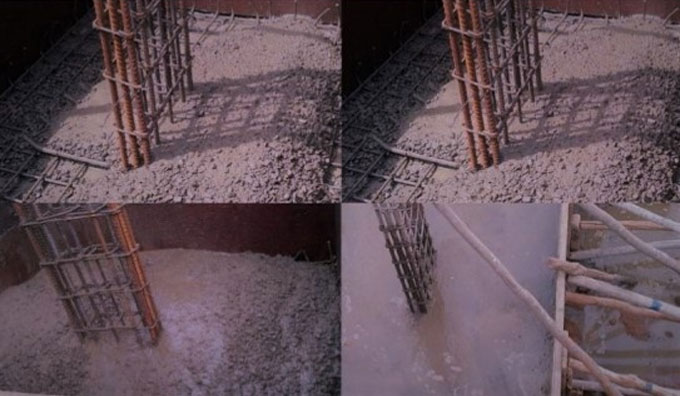
Effect of segregation and bleeding on quality of concrete
Segregation in concrete: Segregation means the detachment of ingredients in concrete. In concrete, the following types of segregations mainly occur:-
1. Detachment of coarse aggregate from the concrete mixture,
2. Detachment of cement pastes from the concrete throughout its plastic phase.
3. Detachment of water from the concrete mix (Bleeding in concrete)
Concrete is formed by mixing cement, fine and coarse aggregates. In a standard quality concrete, is all the ingredients are grouped properly to develop a uniform mixture. Segregation in concrete is primarily occurred due to variations in specific gravities of the ingredients.
Specific gravity of Cement remains among 3.1-3.6g/cc, and for aggregate it remains among 2.6-2.7g/cc. Because of this variation, the aggregate is detached from the matrix and segregation in concrete occurred.
There are various other factors to create segregation in concrete :-
1. Moving concrete mixes for long distances.
2. Weak mix ratio, where adequate matrix does not exist to unite the aggregates.
3. When concrete falls from over 1m.
4. Vibrating concrete for a prolonged period.
Guidelines to reduce segregation in concrete:-
Segregation is managed properly with exact mix ratio.
Handling, placing, transporting, compacting and finishing of concrete in perfect manner.
With the addition of air entraining agents, admixtures and pozzolanic materials in the mix, the segregation is controlled to some extent.
Bleeding in concrete: Bleeding is a type of segregation in which existing water in the concrete mix is forced upwards owning to the settlement of cement and aggregate. Since specific gravity of water is low, the water may proceed upwards. Bleeding normally occurs in the wet mix of concrete.
Due to greater amount of water cement ratio, the bleeding is found in concrete. If the water-cement ratio is higher, the concrete becomes weak and as a result excessive bleeding happens.
The bleeding in concrete is not a cause of great concern when the rate of evaporation of water is identical to the rate of bleeding. Normal bleeding improves the workability of concrete.
When the concrete becomes completely plastic, bleeding is not injurious. However, concrete still remains in the plastic stage and it is subsidized and compacted in due course.
How bleeding impacts the stability of concrete :-
1. Since water is pushed upwards in bleeding, sometimes with this water, specific amount of cement proceeds together with water to the concrete surface. If the top surface is worked up with the trowel, the aggregate comes downward and cement paste is developed at the top surface and it is known as ?Laitance in concrete.? As Laitance is developed, the wearing strength of structure is reduced and the longevity of structure is hampered.
2. While directing to the top from bottom, water produces continuous channels. Because of these channels, concrete turns out to be porous and facilitates water to move, that develops water voids in the matrix and decreases the bond among aggregate and the cement paste.
3. If water is accumulated at the top surface of concrete, the surface finishing is deferred.
4. Concrete becomes porous and its consistency is affected.
5. Excessive bleeding results in rupturing the bond among the reinforcement and concrete.
Remedies to control the bleeding :-
1. Bleeding in concrete is managed with the inclusion of minimum water content in the concrete mix.
2. Allowing the application of air en-training admixtures in the mix.
3. By providing more cement in the mix.


